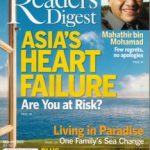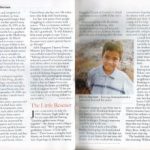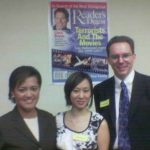Youtube Subscribers
Reader’s Digest: A DREAM TAKES FLIGHT
I was privileged to meet Tony Fernandes at the YES Summit in Kuala Lumpur. He is one charismatic man. Despite his crazy schedule and global stature, he personally answered my emails. How cool is that? Here is a piece that I wrote for the Reader’s Digest Asia.
Donning an AirAsia cap, Dato’ Sri Tony Fernandes, speaker at the first South East Asian Youth Engagement Summit, goes up the stage of Kuala Lumpur’s Putrajaya International Convention Center followed by four flight attendants in AirAsia’s chili red garb. The casually dressed CEO of AirAsia announces that the first person to hand him something red will win a trip to London. Two youth delegates scamper up the stage, one of them tripping on her own two feet before reaching Fernandes. The 45-year-old businessman decides to give both of them the free trip anyway. This scenario is a good illustration of how Fernandes built his low-cost airlines from the ground up — by enticing would-be passengers with free trips.
In 2001, Fernandes was the embattled South East Asia Regional Vice-President for the Warner Music Group. Piracy was causing the company to lose money and he was getting bored with his job. Having ‘dinner’ at a bar one night, he saw an Easy Jet television ad. He realized this was what he wanted to do — build a low-cost, no frills Malaysian airline so everyone could fly. He called his wife and told her of his plan, but couldn’t get a word in because she couldn’t stop laughing.
Fernandes mortgaged his house and then rallied a couple of his buddies1 in the music industry to set up Tune Air Sdn. Bhd. Their license application, however, was turned down by the Malaysian government. Fernandes quickly arranged a meeting with then Prime Minister Dr. Mahathir Mohamad. The Prime Minister suggested that, instead of getting a license, Fernandes should buy the fledgling AirAsia, a heavily indebted subsidiary of a government-owned conglomerate.
With youthful audacity he announced, “I will buy Air Asia for one Malaysian ringgit!” He got this reply: “Yes, you can buy it tomorrow.”
Fernandes might have gotten the airline at one ringgit (US$0.029) but he and his partners also inherited 40 million ringgit worth of debt. His vision, nevertheless, went took flight that same year with 250 employees and two ageing Boeing 737-300 flying to just one destination. A tragic event however, threatened to crash his dream.
The September 11 attacks made people afraid to fly. But Fernandes saw a golden opportunity in what could have been a major setback. Airline leasing costs plummeted by 40 percent, saving the company a lot of money. Airline lay-offs allowed him to hire experienced staff at lower costs. A year later AirAsia had paid off all its debt and broken even.
Fernandes with former CNN host Lorraine Hahn
“We Asians have this habit of kicking ourselves on the foot and saying it can’t be done. Anything is possible when you put your mind into it,” he says. Nine years later, AirAsia is the fastest growing low-cost airline in the world, carrying a total of 85 million passengers to date, with 7,000 employees and 90 new airplanes flying to over 130 destinations in Asia, Australia and Europe.
Fernandes, a London School of Economic alumnus, is a laid-back CEO. “I go to work wearing regular clothes. My pants are sometimes older than my employees”. And he runs AirAsia with a unique set of principles. For one, the company has a flat structure, where everybody has access to the big boss. By removing company bureaucracy, he gets everybody talking and giving invaluable ideas. “People are our best assets. Get the best people and let them grow. Let them fulfill their dreams. Help them discover potential they never thought they had,” he admonishes.
When the company was still relatively small, Fernandes used to go undercover at least once a month as a bag carrier, check-in officer and even flight attendant for a day. It allowed him to get on the ground and see real problems and needs. It also gave him the chance to spot potential stars in the company. When he learned that some bag carriers dreamt of becoming pilots, he sponsored their training. He’s proud of the fact that “eighteen months later they are flying planes.” AirAsia also boasts of having 35 female pilots in their staff. “If women can run a country, they can certainly fly a plane!” he exclaims.
Fernandes ends his well-applauded speech by encouraging the summit delegates with his credo: “Dream the impossible, believe the unbelievable and never take ‘No’ for an answer!”
Q&A with Tony Fernandes
Q: What have you learned about the flying habits of South East Asians?
A: Southeast Asians are practical consumers when it comes to travel. We are particularly attuned to getting value. There is this price sensitivity common among us, which is good because it makes us stop to consider just what we’re getting for what we’re spending. This is not to say that we pick up whatever is cheaper, but that we value a fair exchange and expect good quality products and services for the money that we spend. Also, Southeast Asians love to travel, and we like visiting our neighboring ASEAN countries. The region is breathtakingly beautiful, incredibly diverse, blessed with a rich history, gifted with spectacular natural attractions, and populated by probably the friendliest people on earth. And this 600-milion-strong region is AirAsia’s base.
Q: Is the LCC (low-cost carrier) model sustainable?
A: Yes, and the success of AirAsia attests to the sustainability of the low-cost model. Not only is the low-cost model sustainable, it is also profitable. AirAsia now is Asia ’s leading and largest low-cost airline. And we’ve been operationally profitable every year. It’s worked so well that we have launched AirAsia X, our low-cost, long haul affiliate and which is demonstrating that the model can work even on long-haul flights.
Q:How did you get the company out of debt?
A: First, we saw to it that we had a product that people want. We came up with fares that everybody can afford, routes that people want and need, and high quality basic services. We put in measures to maximize resources and trim costs. We implemented a 25-minute turnaround time for our flights, limited idle time for our aircraft, pushed the Web as a booking channel, and promoted a no-wastage practice in all our operations. We also invested in technology and marketing. We invested in projects, such as sponsorship of Manchester United, which raised awareness about the AirAsia brand not only in ASEAN, but globally.
Q: How do you manage a company with a flat structure?
A: It’s actually less time-consuming. A flat structure makes communication so much easier. With everyone in the team able to directly raise an idea or provide feedback, we’re able to more quickly and efficiently deal with concerns. We don’t lose time climbing the steps of hierarchy just to get an idea across.
Q: Who inspires you and what drives you?
A: My mom has always been my big inspiration. She was so full of life, and I was very close to her while growing up. My colleagues at AirAsia also inspire me. The team’s dedication in achieving our goals is amazing, and they keep our dream of letting everyone fly going.
-Text and photos by JYC
This was written for Reader’s Digest Asia April 2010 issue




 Jenn C.
God-lover.
Milk & TV Producer.
Writer.
Entrepreneur. Natural Health Advocate.
Jenn C.
God-lover.
Milk & TV Producer.
Writer.
Entrepreneur. Natural Health Advocate.





